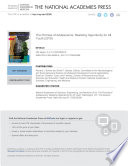Adolescence—beginning with the onset of puberty and ending in the mid-20s—is a critical period of development during which key areas of the brain mature and develop. These changes in brain structure, function, and connectivity mark adolescence as a period of opportunity to discover new vistas, to form relationships with peers and adults, and to explore one’s developing identity. It is also a period of resilience that can ameliorate childhood setbacks and set the stage for a thriving trajectory over the life course. Because adolescents comprise nearly one-fourth of the entire U.S. population, the nation needs policies and practices that will better leverage these developmental opportunities to harness the promise of adolescence—rather than focusing myopically on containing its risks. This report examines the neurobiological and socio-behavioral science of adolescent development and outlines how this knowledge can be applied, both to promote adolescent well-being, resilience, and development, and to rectify structural barriers and inequalities in opportunity, enabling all adolescents to flourish.

